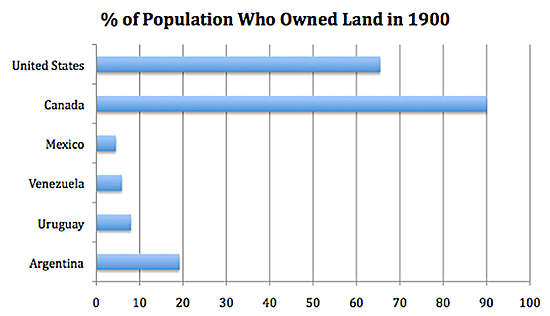
Unit 4: Nationalism, Industrialism, and Imperialism
Lesson F: Imperialism and the New World of the Americas
Activity 5: Analyzing and Researching Economic Data
In this activity you will examine some economic data from Latin America to draw conclusions about the overall economy of Latin America.
Written Activity - Notebook
As you examine the following graphs and charts, answer the following questions in your notebook.
- What patterns do you notice from examining these data?
- How do these data help you better understand the economic and social conditions of Latin America?
- What other data would you like to have in order to better understand Latin America’s economy in the 19th century?

[1]
| Year | United States | Great Britain | Africa | Latin America |
|---|---|---|---|---|
1600 |
$400.00 |
$974.00 |
$414.00 |
$503.00 |
1700 |
$527.00 |
$1250.00 |
$422.00 |
$703.00 |
1820 |
$1257.00 |
$1706.00 |
$420.00 |
$713.00 |
1870 |
$2445.00 |
$3190.00 |
$500.00 |
$749.99 |
1900 |
$4091.00 |
$4492.00 |
$500.00 |
$1200.00 |
1930 |
$6213.00 |
$5441.00 |
$550.00 |
$1914.00 |
| Country | Main Product | Percentage of Economy |
|---|---|---|
Costa Rica |
Bananas and coffee |
86.1 |
Cuba |
Sugar and tobacco |
91.5 |
Peru |
Sugar |
37.4 |
Venezuela |
Cacao and coffee |
73.4 |
Classroom Activity - Researching Economies
![]() Discussion
Discussion
Directions: The economy of Latin America has changed slightly over the years. For the most part, the basics of the economies of various countries have not changed significantly over the years. In this activity you will work with a partner to research the current economy of a country. After you have researched the current economy of a country you should determine how much the economy has changed in the past century.
![]() Download Student Resource: Economic History of a Select Country (doc).
Download Student Resource: Economic History of a Select Country (doc).
![]() Submit your research to your teacher as instructed.
Submit your research to your teacher as instructed.
Page Notes:
[1] Source: This information from Oxford University Press is in the public domain.
[2] Source: This information from Oxford University Press is in the public domain.
[3] Source: This information from Oxford University Press is in the public domain.

